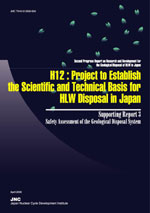Japan Atomic Energy Agency
Geological Isolation Research and Development
H12 report
Supporting Report 3
safety Assessment of the Geological Disposal System
I Introduction
1.1 Concept of geological disposal in Japan
1.2 Features of the safety assessment and general methodology
1.3 Objectives and scope of the H12 safety assessment
1.4 Structure of Supporting Report 3
II Safety Assessment Methodology
2.1 The AEC Guidelines
2.2 Development and treatment of safety assessment cases
2.3 Modeling strategy
2.4 Confidence in the safety assessment
III Geological Disposal System
3.1 Geological environment
3.2 Repository
3.3 Geosphere-biosphere interface (GBI)
3.4 Reference system
3.5 Safety functions
IV Scenario Development
4.1 Scenario development methodology
4.1.1 Scenario classification
4.1.2 Scenario development procedure
4.1.3 Identification and classification of relevant FEPs
4.1.4 Description and screening of FEPs
4.1.5 Development and treatment of scenarios
4.2 Understanding of the geological disposal system
4.2.1 Features of the geological environment relevant to the functions of the EBS
4.2.2 Phenomena related to the safety functions of the EBS and host rock
4.2.3 Phenomena which may perturb the safety functions of the EBS and host rock
4.2.4 Phenomena which may disturb the overall disposal system
4.3 Groundwater scenarios
4.3.1 Base scenario
4.3.2 Perturbation scenarios
V Definition of Calculation Cases and Reference Case Analysis
5.1 Definition of groundwater scenario cases
5.1.1 Classification of calculation cases
5.1.2 Primary assumptions for the safety assessment
5.1.3 Performance analysis approach for the geosphere
5.2 Selection of safety-relevant radionuclides considered in the safety assessment
5.3 Reference Case analysis
5.3.1 EBS modeling
5.3.2 Geosphere modeling
5.3.3 Biosphere
5.3.4 Safety assessment model chain
5.3.5 Results for the Reference Case
VI Analysis of Barrier Performance
6.1 Classification of alternative calculation cases
6.1.1 Flux to dose conversion factors derived from various biosphere models
6.1.2 Data and model uncertainty cases
6.1.3 Alternative design and geological environment cases
6.2 Analysis of perturbation scenarios
6.2.1 Natural phenomena
6.2.2 Initial defects of engineered components
6.2.3 Human activities
6.3 Summary of the sensitivity analysis
6.3.1 Findings of the sensitivity analysis
6.3.2 Key factors to be considered in the total system performance analysis
VII Synthesis of Calculation Cases Illustrating Overall System Performance
7.1 Calculation cases
7.1.1 Alternative geological disposal systems
7.1.2 Uncertainties in the assessment
7.2 Comparison of results with overseas safety standards
VIII Reliability of the Safety Assessment
8.1 Development of scenarios, models, codes and databases
8.2 Supplementary safety indicators
8.3 Comparison with other safety assessments
8.4 Natural analogues
IX Summary and Conclusions
